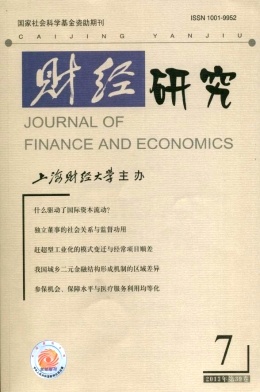什么驱动了国际资本流动?——兼论APEC国家的人口结构效应
财经研究 2013 年 第 39 卷第 07 期, 页码:5 - 16
摘要
参考文献
摘要
生命周期理论认为人口年龄结构会影响储蓄投资行为,储蓄投资和经常账户的人口结构效应表现为与抚养负担的反向关系,但实证文献却并没有达成统一意见。文章尝试建立动态面板和静态面板模型,运用系统广义矩(GMM)、混合最小二乘(PooledOLS)、固定效应(FE)、似无相关回归(SUR)等方法对亚太经合组织(APEC)20个国家或地区1993-2010年的面板数据进行了分析。分析发现,经常账户的人口结构效应表现稳健,呈显著负向关系,但储蓄和投资行为的人口结构效应对于样本和方法比较敏感。具体到人口结构内部,老年抚养比效应表现稳健,反向系数在0.26至0.33之间,少年抚养比效应则较为模糊或微弱。
关键词
[1]朱超,张林杰.人口结构能够解释经常账户平衡吗?[J].金融研究,2012,(5):30-44.
[2]Blundell R,Bond S.Initial conditions and moment restrictions in dynamic panel datamodels[J].Journal of Econometrics,1998,87(1):115-143.
[3]Boyd D,Caporale G M,Smith R.Real exchange rate effects on the balance of trade:Cointegration and the marshall-lerner condition[J].International Journal of Finance&..Economics,2001,6(3):187-200.
[4]Chen K,Imrohoroglu A,Imrohoroglu S.The Japanese saving rate between 1960and2000:Productivity,policy changes,and demographics[J].Economic Theory,2007,32(1):87-104.
[5]Chinn M D,Prasad E S.Medium-term determinants of current accounts in industrialand developing countries:An empirical exploration[J].Journal of International Economics,2003,59(1):47-76.
[6]Chinn M D,Ito H.Current account balances,financial development and institutions:Assaying the world“saving glut”[J].Journal of International Money and Finance,2007,26(4):546-569.
[7]Coale A J,Hoover E M.Population growth and economic development in low-incomecountries:A case study of India’s prospects[M].Princeton,N J:Princeton UniversityPress,1958.
[8]Dayal-Gulati A,Thimann C.Saving in Southeast Asia and Latin America compared:Searching for policy lessons[R].IMF Working Paper,No.110,1997.
[9]Deaton A,Paxson C.Growth,demographic structure,and national saving in Taiwan[J].Population and Development Review,2000,26(Supplement):141-173.
[10]Debelle G,Faruqee H.What determines the current account?A cross-sectional andpanel approach[R].IMF Working Paper,No.58,1996.
[11]Feldstein M,Horioka C.Domestic saving and international capital flows[J].EconomicJournal,1980,90(358):314-329.
[12]Fry M J,Mason A.The variable rate-of-growth effect in the life-cycle saving model[J].Economic Inquiry,1982,20(3):426-442.
[13]Gruber J W,Kamin S B.Explaining the global pattern of current account imbalances[J].Journal of International Money and Finance,2007,26(4):500-522.
[14]Higgins M,Williamson J G.Age structure dynamics in Asia and dependence on foreigncapital[J].Population and Development Review,1997,23(2):261-293.
[15]Horioka C Y,Wan J.The determinants of household saving in China:A dynamic panelanalysis of provincial data[J].Journal of Money,Credit and Banking,2007,39(8):2077-2096.
[16]Kim S,Lee J W.Demographic changes,saving,and current account:An analysis basedon a panel VAR model[J].Japan and the World Economy,2008,20(2):236-256.
[17]Leff N H.Dependency rates and savings rates[J].The American Economic Review,1969,59(5):886-896.
[18]Obstfeld M,Rogoff K.The intertemporal approach to the current account[R].Hand-book of International Economics,Elsevier,1995.
[19]Ram R.Dependency rates and aggregate savings:A new international cross-sectionstudy[J].The American Economic Review,1982,72(3):537-544.
[20]Roodman D.How to do Xtabond2:An introduction to difference and system GMM in..Stata[R].Center for Global Development Working Paper,No.103,2006.
[21]Terrones M,Cardarelli R.Global imbalances:A saving and investment perspective[R].IMF,World Economic Outlook,2005.
[22]Ul Haque N,Pesaran M H,Sharma S.Neglected heterogeneity and dynamics in cross-country savings regressions[R].IMF Working Paper,No.128,1999.
[23]Zellner A.An efficient method of estimating seemingly unrelated regressions and testsfor aggregation bias[J].Journal of the American Statistical Association,1962,57(298):348-368.
[2]Blundell R,Bond S.Initial conditions and moment restrictions in dynamic panel datamodels[J].Journal of Econometrics,1998,87(1):115-143.
[3]Boyd D,Caporale G M,Smith R.Real exchange rate effects on the balance of trade:Cointegration and the marshall-lerner condition[J].International Journal of Finance&..Economics,2001,6(3):187-200.
[4]Chen K,Imrohoroglu A,Imrohoroglu S.The Japanese saving rate between 1960and2000:Productivity,policy changes,and demographics[J].Economic Theory,2007,32(1):87-104.
[5]Chinn M D,Prasad E S.Medium-term determinants of current accounts in industrialand developing countries:An empirical exploration[J].Journal of International Economics,2003,59(1):47-76.
[6]Chinn M D,Ito H.Current account balances,financial development and institutions:Assaying the world“saving glut”[J].Journal of International Money and Finance,2007,26(4):546-569.
[7]Coale A J,Hoover E M.Population growth and economic development in low-incomecountries:A case study of India’s prospects[M].Princeton,N J:Princeton UniversityPress,1958.
[8]Dayal-Gulati A,Thimann C.Saving in Southeast Asia and Latin America compared:Searching for policy lessons[R].IMF Working Paper,No.110,1997.
[9]Deaton A,Paxson C.Growth,demographic structure,and national saving in Taiwan[J].Population and Development Review,2000,26(Supplement):141-173.
[10]Debelle G,Faruqee H.What determines the current account?A cross-sectional andpanel approach[R].IMF Working Paper,No.58,1996.
[11]Feldstein M,Horioka C.Domestic saving and international capital flows[J].EconomicJournal,1980,90(358):314-329.
[12]Fry M J,Mason A.The variable rate-of-growth effect in the life-cycle saving model[J].Economic Inquiry,1982,20(3):426-442.
[13]Gruber J W,Kamin S B.Explaining the global pattern of current account imbalances[J].Journal of International Money and Finance,2007,26(4):500-522.
[14]Higgins M,Williamson J G.Age structure dynamics in Asia and dependence on foreigncapital[J].Population and Development Review,1997,23(2):261-293.
[15]Horioka C Y,Wan J.The determinants of household saving in China:A dynamic panelanalysis of provincial data[J].Journal of Money,Credit and Banking,2007,39(8):2077-2096.
[16]Kim S,Lee J W.Demographic changes,saving,and current account:An analysis basedon a panel VAR model[J].Japan and the World Economy,2008,20(2):236-256.
[17]Leff N H.Dependency rates and savings rates[J].The American Economic Review,1969,59(5):886-896.
[18]Obstfeld M,Rogoff K.The intertemporal approach to the current account[R].Hand-book of International Economics,Elsevier,1995.
[19]Ram R.Dependency rates and aggregate savings:A new international cross-sectionstudy[J].The American Economic Review,1982,72(3):537-544.
[20]Roodman D.How to do Xtabond2:An introduction to difference and system GMM in..Stata[R].Center for Global Development Working Paper,No.103,2006.
[21]Terrones M,Cardarelli R.Global imbalances:A saving and investment perspective[R].IMF,World Economic Outlook,2005.
[22]Ul Haque N,Pesaran M H,Sharma S.Neglected heterogeneity and dynamics in cross-country savings regressions[R].IMF Working Paper,No.128,1999.
[23]Zellner A.An efficient method of estimating seemingly unrelated regressions and testsfor aggregation bias[J].Journal of the American Statistical Association,1962,57(298):348-368.
引用本文
朱超, 林博. 什么驱动了国际资本流动?——兼论APEC国家的人口结构效应[J]. 财经研究, 2013, 39(7): 5–16.
导出参考文献,格式为:
上一篇:提高劳动者工资损害公司价值吗?





 6054
6054  3257
3257

